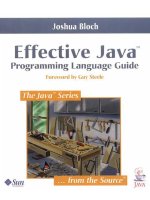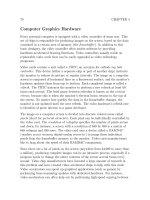Effective Java Programming Language Guide phần 3 ppsx
Bạn đang xem bản rút gọn của tài liệu. Xem và tải ngay bản đầy đủ của tài liệu tại đây (423.02 KB, 18 trang )
Effective Java: Programming Language Guide
33
A good hash function tends to produce unequal hash codes for unequal objects. This is exactly
what is meant by the third provision of the hashCode contract. Ideally, a hash function should
distribute any reasonable collection of unequal instances uniformly across all possible hash
values. Achieving this ideal can be extremely difficult. Luckily it is not too difficult to
achieve a fair approximation. Here is a simplerecipe:
1. Store some constant nonzero value, say 17, in an
int variable called result.
2. For each significant field
f in your object (each field taken into account by the equals
method, that is), do the following:
a. Compute an
int hash code c for the field:
i. If the field is a
boolean, compute (f ? 0 : 1).
ii. If the field is a
byte, char, short, or int, compute (int)f.
iii. If the field is a
long, compute (int)(f ^ (f >>> 32)).
iv. If the field is a
float compute Float.floatToIntBits(f).
v. If the field is a
double, compute Double.doubleToLongBits(f), and
then hash the resulting
long as in step 2.a.iii.
vi. If the field is an object reference and this class's
equals method
compares the field by recursively invoking
equals, recursively invoke
hashCode on the field. If a more complex comparison is required,
compute a “canonical representation” for this field and invoke
hashCode
on the canonical representation. If the value of the field is
null
, return
0
(or some other constant, but 0 is traditional).
vii. If the field is an array, treat it as if each element were a separate field.
That is, compute a hash code for each significant element by applying
these rules recursively, and combine these values as described in step
2.b.
b. Combine the hash code
c computed in step a into result as follows:
result = 37*result + c;
3. Return result.
4. When you are done writing the
hashCode method, ask yourself whether equal
instances have equal hash codes. If not, figure out why and fix the problem.
It is acceptable to exclude redundant fields from the hash code computation. In other words, it
is acceptable to exclude any field whose value can be computed from fields that are included
in the computation. It is required that you exclude any fields that are not used in equality
comparisons. Failure to exclude these fields may result in a violation of the second provision
of the
hashCode contract.
A nonzero initial value is used in step 1, so the hash value will be affected by initial fields
whose hash value, as computed in step 2.a, is zero. If zero was used as the initial value in step
1, the overall hash value would be unaffected by any such initial fields, which could increase
collisions. The value 17 is arbitrary.
The multiplication in step 2.b makes the hash value depend on the order of the fields, which
results in a much better hash function if the class contains multiple similar fields. For
example, if the multiplication were omitted from a
String
hash function built according to
this recipe, all anagrams would have identical hash codes. The multiplier 37 was chosen
because it is an odd prime. If it was even and the multiplication overflowed, information
Effective Java: Programming Language Guide
34
would be lost because multiplication by two is equivalent to shifting. The advantages of using
a prime number are less clear, but it is traditional to use primes for this purpose.
Let's apply this recipe to the
PhoneNumber class. There are three significant fields, all of type
short
. A straightforward application of the recipe yields this hash function:
public int hashCode() {
int result = 17;
result = 37*result + areaCode;
result = 37*result + exchange;
result = 37*result + extension;
return result;
}
Because this method returns the result of a simple deterministic computation whose only
inputs are the three significant fields in a
PhoneNumber instance, it should be clear that equal
PhoneNumber instances have equal hash codes. This method is, in fact, a perfectly reasonable
hashCode implementation for PhoneNumber, on a par with those in the Java platform libraries
as of release 1.4. It is simple, is reasonably fast, and does a reasonable job of dispersing
unequal phone numbers into different hash buckets.
If a class is immutable and the cost of computing the hash code is significant, you might
consider caching the hash code in the object rather than recalculating it each time it is
requested. If you believe that most objects of this type will be used as hash keys, then you
should calculate the hash code when the instance is created. Otherwise, you might choose to
lazily initialize it the first time
hashCode
is invoked (Item 48). It is not clear that our
PhoneNumber
class merits this treatment, but just to show you how it's done:
// Lazily initialized, cached hashCode
private volatile int hashCode = 0; // (See Item 48)
public int hashCode() {
if (hashCode == 0) {
int result = 17;
result = 37*result + areaCode;
result = 37*result + exchange;
result = 37*result + extension;
hashCode = result;
}
return hashCode;
}
While the recipe in this item yields reasonably good hash functions, it does not yield state-of-
the-art hash functions, nor do the Java platform libraries provide such hash functions as of
release 1.4. Writing such hash functions is a topic of active research and an activity best left to
mathematicians and theoretical computer scientists. Perhaps a later release of the Java
platform will provide state-of-the-art hash functions for its classes and utility methods to
allow average programmers to construct such hash functions. In the meantime, the techniques
described in this item should be adequate for most applications.
Do not be tempted to exclude significant parts of an object from the hash code
computation to improve performance. While the resulting hash function may run faster, its









